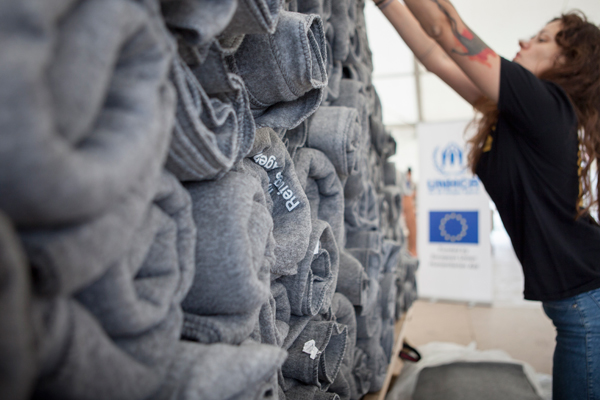Principles and evolution of the European legal framework on asylum and migration

Credits: UNHCR/Yorgos Kyvernitis
On November 4th, the French association France Terre d’Asile (FTA) hosted a symposium to discuss the state of asylum law in Europe. Here follows a summary of the conclusions of the conference, written by France Terre d’Asile’s President Thierry Le Roi and published in French on the FTA website.
“Before trying to draw out the conclusions of our conference, I would like to remember where it all started. After the signing of the March 2016 EU-Turkish agreement, France Terre d’Asile issued a press release denouncing the negative shift of the EU asylum legal system: in the form, for it overstretches the concept of “safe third country”, and paves the way for a discriminatory, limited and fixed channel to access asylum in Europe. In the spirit of this, we externalized and delegated our responsibilities in terms of right to asylum in a third country. But, in fact, Turkey is the only latest example of this European shift. Therefore, we called “the Member States to reflect on the topics of reception and integration of refugees”. Today, we want to be an active partner in this endeavour.
Wanting to catch the whole thing in just one conference might be, of course, a bit pretentious. But sometimes it is necessary to tackle things with a systemic perspective, and we think that this is the right time. All the questions we asked on our three roundtables can be asked at the same time; the EU recently proposed changes to regulations concerning asylum seekers and Member States (the new “asylum package”) as well as those with third countries; more generally speaking, the influx of refugees has become a real obsession for many observers, such as one who wrote last week: “Europe will be rebuilt on this challenge: the management and the integration of the migration wave will be the mark of this century” (Le Monde, 26 October 2016). At France Terre d’Asile, we want to have a clear overview of the issue, for our analysis and for the positions that we defend.
The question of the first roundtable reflected the general question of the gathering: is asylum law the right tool to manage the current migration flow?
Since 2015 (at least), the management of this flow is based on the equivalence of refugees and migrants, asylum seekers and irregular immigrants. Both according to public opinion and governments, the image of an asylum seeker can be replaced with that of a foreigner in an irregular situation. Indeed, there are good reasons for this. A contextual reason above others: the most spectacular migration flows are connected to political rather than economic facts. The fact that Greece, which was and still is, more so than other countries, being confronted with massive numbers of asylum applications, is proof of that, and we had the chance to have a representative from the Greek Council for Refugees at our symposium. A deeper reason, highlighted by the current reflection on the need to protect and on the vulnerability of forced migrants, could be that the asylum legal tools we possess and the status of refugee (Geneva Convention) are no longer sufficient to cover all cases of need for protection (“needs” approach vs. “status” approach). Should we then move on to a protection of migrants rather than only a protection of refugees? Member States, which preserve their competence vis-à-vis the EU to grant residence permits, are led to handle asylum applications as if they were residence permit requests: with quotas based on the country’s reception capacity, and with an “opportunity” approach, which allows the closing of borders and pushing back of migrants, without any respect for the right to asylum. The European Commission itself suggests that the Council should establish a new framework of partnerships with third countries, which would prioritize the management of migration flows, often disregarding the right of asylum that the Tampere Summit (1999) wanted to preserve.
We all heard the representative from the French Ministry of the Interior protesting against such a risk of confusion, which is indeed very unequal among Member States and very often depends on their exposure to the problem. But here at France Terre d’Asile we are sensitive to the claims of the European Council on Refugees and Exiles (ECRE) about the disrupt to the right to asylum. As for most members of the ECRE network, we also stick to these two ideas:
1) The principles of the right to asylum should be less alterable than the ways of putting them into practice. There is certainly room to think about new instruments of protection to tackle the new flows of refugees, whose journeys – and their causes – are no longer like those of the ones of refugees during the 1930s; we could also imagine a diversified plan in the way the right to asylum is implemented in Europe, if case reallocation programmes are successfully put in place. But asylum is a legally established right, an individual right that is open to all those who apply, a right that States have to respect. “Humanitarian asylum” can be added to this right but cannot replace it.
2) The asylum legal framework should be kept separated from other legislations on migration, notwithstanding mixed flows and the resulting difficulty to determine legitimate reasons to grant asylum. This is important because, if there is no general right in Europe for third country nationals to reside in the EU, there should definitely be a right to asylum that is grounded in our history and in the most fundamental legal charters of the European Union.
The second roundtable dealt with the EU dimension in the construction of the right to asylum, with the aim of tracking its origins in the Tampere Summit, where the Member States set the ground for a common European migration policy and reaffirmed their commitment to the “absolute respect of the right to asylum”. However, despite the initial positive attitude, Member States failed to harmonize their systems and have recently proven to lack substantial solidarity among them. The roundtable was moderated by a former Minister of National Solidarity in France and this was not by chance: first of all, it reflects the fact that asylum is first and foremost a need before being a right, and it is requested and granted according to a solidarity principle. Secondly, we strongly believe that solidarity among States is the extension of solidarity mechanisms within a nation. In this session, we wanted to hear about the situations in some specific Member States, such as Greece, Germany and France. Thanks to the contributions of representatives from the European Asylum Support Office (EASO) and the Jacques Delors Institute, we learnt that the European Commission does not wish to give up on the effort to further harmonize procedures and reception conditions (but on what standard?), being aware that a lack of it would result in Member States’ passivity and helplessness to handle “second movements” of refugees, and that solidarity would just remain an empty promise.
We believe that Europe will not overcome its fears, and the populist movements nurtured by them, by stigmatizing the behaviour of the Member States that we often forget to consider with the right perspective (it would be enough to remember that the ratio of asylum seekers in the local population is 18 p/thousand in Hungary and just 0,6 p/thousand in the UK); or by stigmatizing the behaviour of the refugee population, who we tend to blame for their secondary movements. With these limitations in mind, we can be in favour of an evolution of the EU legislation, provided that it ensures the protection and the efficiency of the right to asylum, therefore drawing a distinct line between the fundamental principles of this right (the right to international protection) and the implementation guidelines laid down to guarantee its respect in the Member States. Namely:
– With the Dublin IV Regulation, the European Commission proposes a solidarity allocation mechanism to correct the effects of the first-country-of-arrival responsibility rule. Is it necessary to create more voluntary mechanisms, monetary incentives and compulsory quotas in order to make solidarity more efficient? This is the problem often faced by diplomats, as explained by Mr. Vimont during the panel session. As for us, we have repeatedly asked for a significant recast of the Dublin regulation and its criteria, which are far too often distant from refugees’ aspirations and from their family and language ties;
– The rules followed by Member States to process asylum applications. We believe that the rule of one single asylum application in one single EU Member States does not violate the principles of the right to asylum. Rather, it accounts for a minimum level of discipline among Member States and for asylum seekers, for what concerns their freedom to circulate within the EU (secondary movements), but only if this freedom is actually granted (mutual recognition of decisions).
On the third roundtable, we dealt with third countries, countries of origin or countries of transit, which have become more and more of a pressing issue for Europe over the last few months. For a long time now, Member States (12, today) complemented the right to asylum as stated in the Geneva Convention with the notion – and a list – of safe third countries, which designates a country of transit between the country of origin of the refugee and the European Union, where the asylum seeker aspires to find protection. This concept, which in our opinion contradicts art. 3 of the Geneva Convention, makes the safe third country responsible for the application and reception of the asylum seeker.
At the same time, the EU and its Member States have for a long time been discussing with these third countries ways to manage and stem migration flows, sometimes bringing up “co-development” strategies to work on the root causes of migration or cooperation tools to set up protection regimes for refugees. With this aim in mind, a wide range of agreements were signed, often called “visa” or “migration” agreements, or in other cases “readmission” agreements. As an example, in 2013 the EU started a partnership with Morocco to establish a Moroccan national asylum system. The frame of these treaties and collaborations is what the European Commission called the “Global approach to migration”, which also recently included the new package of regulations’ recasts proposed by the European Commission to the Parliament and the Council last June. It is important for us to highlight how these new legal propositions do not draw a clear line between asylum and other forms of migration.
The roundtable explored the difficulties and the critiques that these two modes of action were confronted with. Our panellists emphasized the risk connected to the use of the concept of safe third country, when it justifies the implementation of hasty asylum application procedures that are very slightly compatible with the principle of individual examination or, in the worst case scenario, that lead to a total shut down of borders (as happened in Turkey). The speakers showed us how difficult it will be for the EU to define, in less than three years, the common criteria and a list of safe third countries. How could we avoid the basic and procedural distortions that are being applied to the right to asylum? On this specific topic, the bad news lies in the details: we need precise and concrete guarantees, which are not dependent on the diplomatic considerations that inevitably impact on the designation of a safe third country.
Cooperation can be a useful tool, but only if the partner third country promotes it. For example, Tunisia shows how some good and useful work can be conducted to elaborate the right to asylum together with civil society actors. Also Turkey had started to work on the creation of a legal asylum apparatus in 2011, before the Syrian conflict. But we have also seen what can be achieved when the EU is put under pressure to sign agreements that aim to protect its external borders: in addition to the March agreement with Turkey, in October 2016 the EU signed a new treaty with Afghanistan. This is what makes us sceptical about a partnership framework that tends to organize relationships with third countries around the objectives of migrants’ readmission and return, disregarding the right to asylum.
Third countries are therefore among the priorities of the EU agenda. On this issue, we would like to make some remarks:
– We are far from being persuaded that the notion of safe third country could ensure the proper application of the right to asylum.
– In the cooperation with third countries, the EU should discuss asylum and not only migration. The EU should make sure that its partner is determined to comply with the principles of the right to asylum.
– The dialogue between the EU and these countries should be balanced, meaning that the EU should not outsource its responsibility to process asylum applications to third countries.
– The objective of international protection should include an analysis of the needs and possible solutions (such as resettlement programs in EU Member States, instruments to ensure protection all along the migratory path) or shared solidarity programs (visa systems allowing the circulation of migrants between the EU and third countries of reception; EU-funded training programs for refugees before they return to their countries of origin).
– Finally, a suggestion for our future action at France Terre d’Asile: we should think about expanding our action in third countries.”




